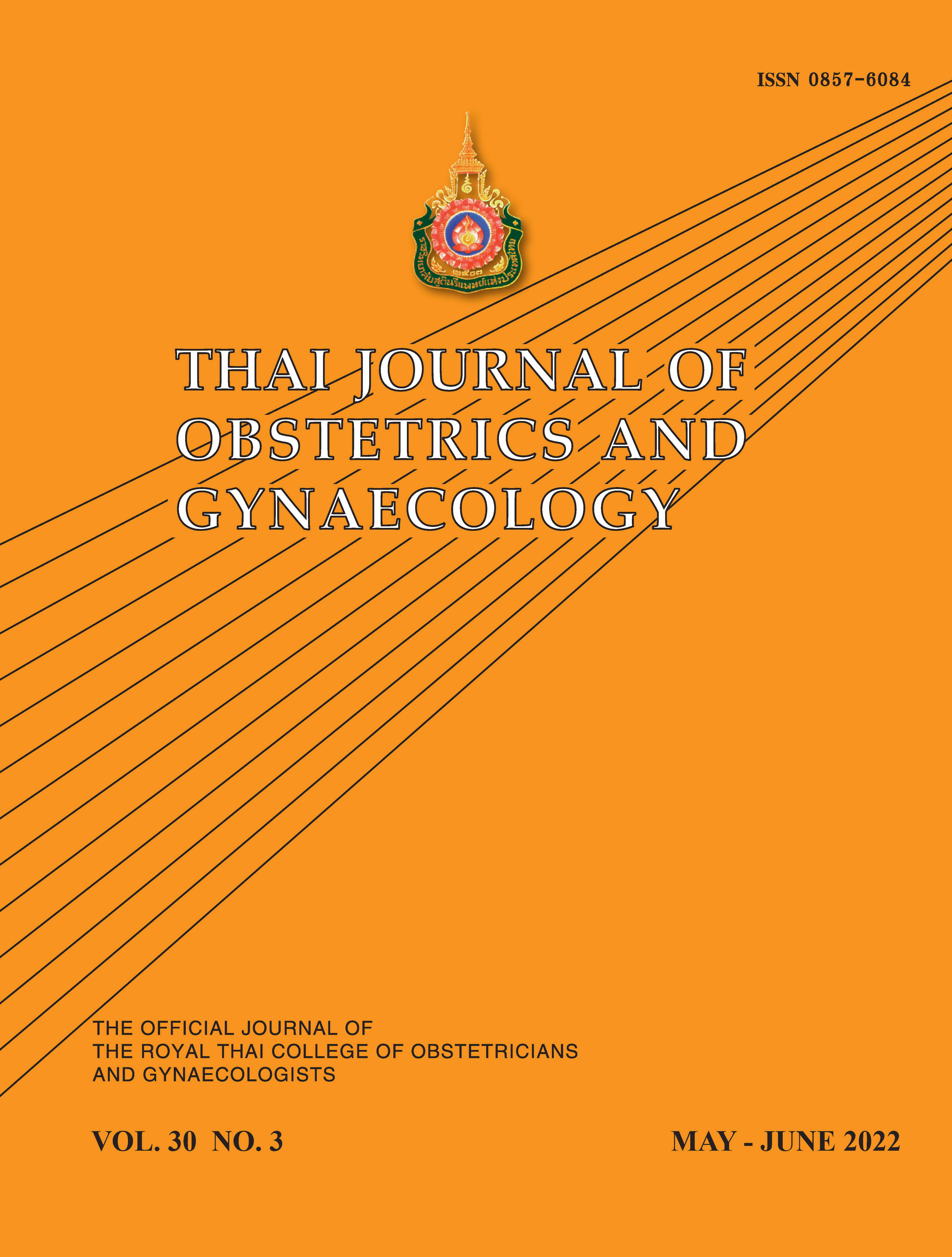Female Sexual Dysfunction among Thai Women Using Hormonal Contraception versus Tubal Sterilization
Main Article Content
Abstract
Objectives: Contraception is accepted worldwide by women to prevent unintended pregnancy. This study was aimed to evaluate female sexual function in women using hormonal contraception and tubal sterilization.
Materials and Methods: This was a cross-sectional study. Sexually active women 20-45 years old who used hormonal contraception or underwent tubal sterilization for at least 3 months were included. The participants self-completed the Thai version of the female sexual function index (FSFI) questionnaire to determine female sexual dysfunction (FSD) which consisted of six domains including sexual desire, sexual arousal, lubrication, orgasm, sexual satisfaction and pain. Demographic data were collected.
Results: A total of 310 women were recruited for this study. There were 155 participants who used hormonal contraception (79 used oral combined contraceptive pills, 56 used the depot medroxyprogesterone acetate (DMPA) and 20 used an implant) and 155 women underwent tubal sterilization. The prevalence of FSD was 70.9% and 64.5% in hormonal contraception group and tubal sterilization group. There was no statistically significant difference in the FSD between the groups (p = 0.224). The overall median FSFI score for hormonal contraception users was marginally and statistically significantly lower than tubal sterilization group (p = 0.054). Meanwhile, parity was the only significant associated factor that affected the FSD (adjusted odds ratio 3.32, 95% confidence interval 1.43 - 7.70).
Conclusion: The prevalence of FSD was high in both hormonal contraception users and the tubal sterilization group. Parity was the only significant associated factor that affected FSD.
Article Details

This work is licensed under a Creative Commons Attribution-NonCommercial-NoDerivatives 4.0 International License.
References
World Health Organization. Sexual health and its linkages to reproductive health: an operational approach. Geneva, Switzerland 2017.
Althof SE, Leiblum SR, Chevret-Measson M, Hartmann U, Levine SB, McCabe M, et al. Psychological and interpersonal dimensions of sexual function and dysfunction. J Sex Med 2005;2:793-800.
Costello C, Hillis SD, Marchbanks PA, Jamieson DJ, Peterson HB, US Collaborative Review of Sterilization Working Group. The effect of interval tubal sterilization on sexual interest and pleasure. Obstet Gynecol 2002;100:511-7.
Butt MR, Lema V, Mukaindo A, Mohamoud G, Shabani J. Prevalence of and factors associated with female sexual dysfunction among women using hormonal and non-hormonal contraception at the AGA Khan University Hospital Nairobi. Afr J Prim Health Care Fam Med 2019;11:e1-9.
Casey PM, MacLaughlin KL, Faubion SS. Impact of contraception on female sexual function. J Women Health 2017;26:207-13.
Ertekin Pinar S, Demirel G, Yildirim G, Daglar G. Sexual experiences and quality of life in Turkish women using methods of contraception. J Obstet Gynaecol 2019;39:782-7.
Smith NK, Jozkowski KN, Sanders SA. Hormonal contraception and female pain, orgasm and sexual pleasure. J Sex Med 2014;11:462-70.
Gulum M, Yeni E, Sahin MA, Savas M, Ciftci H. Sexual functions and quality of life in women with tubal sterilization. Int J Impot Res 2010;22:267-71.
Sadatmahalleh SJ, Ziaei S, Kazemnejad A, Mohamadi E. Evaluation of sexual function and quality of life in Iranian women with tubal ligation: a historical cohort study. Int J Impot Res 2015;27:173-7.
Panchalee T, Wongwananuruk T, Augsuwatana S, Sirimai K, Tammakunto M, Neangton C, et al. Prevalence and associating factors of sexual dysfunction in women who use intrauterine device (IUD) for contraception. J Med Assoc Thai 2014;97:20-7.
Cain VS, Johannes CB, Avis NE, Mohr B, Schocken M, Skurnick J, et al. Sexual functioning and practices in a multi-ethnic study of midlife women: baseline results from SWAN. J Sex Res 2003;40:266-76.
Meston CM, Ahrold T. Ethnic, gender, and acculturation influences on sexual behaviors. Arch Sex Behav 2010;39:179-89.
American Psychiatric Association. Diagnostic and statistical manual of mental disorder: DSM-5. Washington DC 2013.
Wiegel M, Meston C, Rosen R. The female sexual function index (FSFI): cross-validation and development of clinical cutoff scores. J Sex Marital Ther 2005;31:1-20.
FSFI-Female sexual function index [Internet]. http://eprovide.mapi-trust.org/instruments/female-sexual function index. [cited 2000 Feb 17]. Available from: http://eprovide.mapi-trust.org/instruments/female-sexual function index
Kunkeri SP, Sathyanarayana Rao TS, Andrade C. Study of sexual functioning and disorder in women before and after tubal sterilization (tubectomy). Indian J Psychiatry 2017;59:63-8.
Both S, Lew-Starowicz M, Luria M, Sartorius G, Maseroli E, Tripodi F, et al. Hormonal contraception and female sexuality: Position Statements from the European Society of Sexual Medicine (ESSM). J Sex Med 2019;16:1681-95.
Wallwiener CW, Wallwiener L-M, Seeger H, Schönfisch B, Mueck AO, Bitzer J, et al. Are hormonal components of oral contraceptives associated with impaired female sexual function? A questionnaire-based online survey of medical students in Germany, Austria, and Switzerland. Arch Gynecol Obstet 2015;292:883-90.
Lewis RW. A critical look at descriptive epidemiology of sexual dysfunction in Asia compared to the rest of the world - a call for evidence-based data. Transl Androl Urol 2013;2:54-60.
Laumann EO, Nicolosi A, Glasser DB, Paik A, Gingell C, Moreira E, et al. Sexual problems among women and men aged 40-80 y: prevalence and correlates identified in the Global Study of Sexual Attitudes and Behaviors. Int J Impot Res 2005;17:39-57.
Boozalis A, Tutlam NT, Chrisman Robbins C, Peipert JF. Sexual desire and hormonal contraception. Obstet Gynecol 2016;127:563-72.
Guida M, Cibarelli F, Troisi J, Gallo A, Palumbo AR, Di Spiezio Sardo A. Sexual life impact evaluation of different hormonal contraceptives on the basis of their methods of administration. Arch Gynecol Obstet 2014;290:1239-47.
Banaei M, Alidost F, Ghasemi E, Dashti S. A comparison of sexual function in primiparous and multiparous women. J Obstet Gynaecol 2020;40:411-8.
Jahan MS, Billah SMB, Furuya H, Watanabe T. Female sexual dysfunction: facts and factors among gynecology outpatients. J Obstet Gynaecol Res 2012;38:329-35.
McCool-Myers M, Theurich M, Zuelke A, Knuettel H, Apfelbacher C. Predictors of female sexual dysfunction: a systematic review and qualitative analysis through gender inequality paradigms. BMC Women Health 2018 22;18:108.
Pacific WHORO for the W. The Asia-Pacific perspective: redefining obesity and its treatment [Internet]. Sydney : Health Communications Australia; 2000 [cited 2020 Oct 29].


